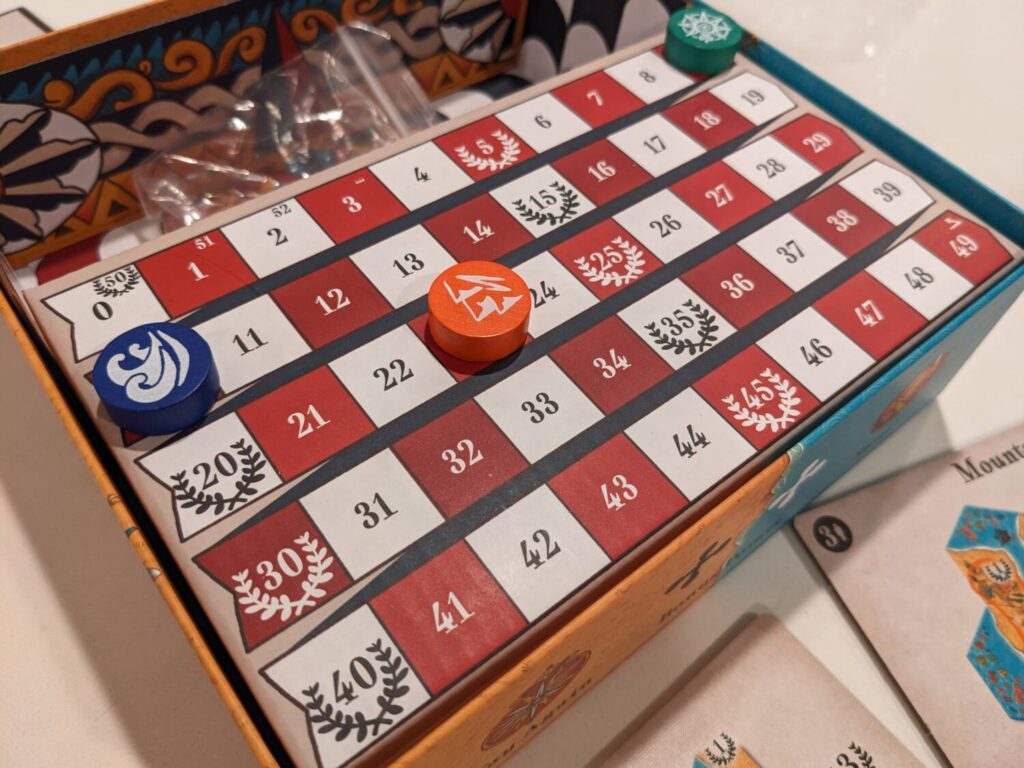Here’s my bold opening: I think Carcassone is only OK.
Carcassonne, released more than 20 years ago, is the quintessential tile-laying classic in the eyes of most people I know, and many of the people who write for our site. Carcassonne won the prestigious Spiel des Jahres in 2001, and has been reimplemented more than a dozen times in various formats for gamers of all shapes and sizes.
But each time I play Carcassonne, I shrug my shoulders. Great design, and I can see the depth; it’s just not something I itch to play regularly. Never, at any point in my gaming life, have I been sitting somewhere when a player shouted:
“Hey everyone! I’m so fired up to play Carcassonne! WHO’S WITH ME!!!!”
When Land vs Sea (2021, Good Games Publishing) hit my table, I immediately noticed similarities with this game and Carcassonne. The two are certainly different enough; Land vs Sea has multiple play formats that distance it from Carcassonne, and I like the simple approach in the two-player version of the game. One player is Land, the other is Sea, and each only scores when tiles are laid that complete pictures featuring their faction.
The two-player version of this game, as my colleague Bob Pazehoski, Jr. agrees, is interesting. The three-player version of this game, though? Hard pass.

Twos, Threes, Fours
Land vs Sea is so easy to teach that Bob’s mini-review in a previous First Take Friday article (now known as “Quick Peaks) covers the basics. The game is meant to be played as a 1v1 puzzle, with the offer of three- and four-player variants if more people show up at your kitchen table.
Each player always has two tiles at the end of their turn, to plan future moves. On a turn, a player looks at their double-sided tiles to determine where they can legally lay a tile that will either extend or close off a land or sea area of the ever-growing tile area. Then, they place that tile; if the edges on their tile close off a sea area, the Sea player will score points equal to the number of tiles included in the Sea area. Ditto for Land; no matter who closes off a section, the Land or Sea player will score for their terrain type.
There are bonus points located on many of the tiles, represented by small Xs. The active player who closes a section gets the bonus points on the closed terrain type, while the section itself still scores only for the player who owns that terrain type. After a player draws up to two tiles, turns pass to the next player.
Turns go on like this until the draw pile of approximately 60 tiles are all played. The four-player version of Land vs Sea plays the same way, but Land and Sea are each two-person teams instead of a single player.

Additional scoring modules spice things up a bit. Mountains and Coral introduces an extra scoring element when closing off sections; Caravans and Ships scores points for the player who plays a Caravan next to a Ship right away, and vice versa.
The game changes a bit with three players, with the introduction of the Cartographer. Talk about a third wheel; Land vs Sea doesn’t feel quite right when it is known as Land vs Sea vs Cartographer.
The Cartographer can only score with those bonus Xs and the expansion scoring modules, and in my brief experience with the three-player mode (only one of my plays was at three players), I won’t be going back to it.
Playing as the Cartographer is the ultimate kingmaking experience. Using their own hand of tiles (drawn from the same stacks as other players), the Cartographer spends every turn trying to math out places where they can lay a tile, try to grow networks of mountains or corals in sections that Land or Sea might ideally want to close off, and try to score bonus points, which represents the majority of their scoring opportunities, per my experience and the game’s manual. As usual, closing off a land section scores points for the Land player, so the Cartographer is usually helping another player while trying to complete their turns.
It just doesn’t fit.

Head to Head is a Yes…Just Bring Drinks
Land vs Sea is interesting at two players. It’s more of a puzzle than a game in my eyes, because there’s a bit of randomness to the tile draw while trying to both build up your network while messing with your opponent. It’s also a bit too big for its britches—the game usually runs about 45 minutes, which felt 15 minutes too long for a game that has maybe three rules.
The three-player game of Land vs Sea took just over an hour; that was my first play, so it went a little longer because we were taking longer turns to figure out the best ways to score. But we were all shocked how long it takes to get through all of the tiles. You could house-rule this to shorten the game, but I shouldn’t have to do that to keep things fresh. You will never play this game fast because players want to consider the best ways to lay tiles and maximize scores for their faction.
Land vs Sea, at two players, wasn’t bad. But after each game, every other player said they wouldn’t want to play it again. That was my sense, too.












I like Carcassonne. It can be a fun and interesting diversion. Hunters and Gatherers is the implementation, in my opinion.
Given the way this little game works, I can certainly understand why two players is about as good as it would get.
So yea… you hit the nail on the head — great review.